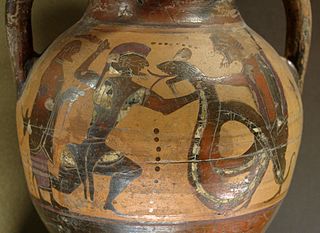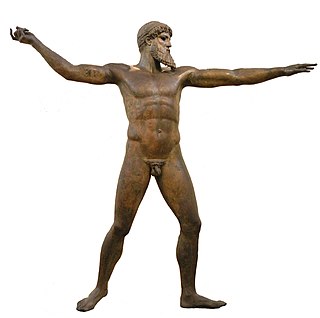| Look up Poseidonia , Ποσειδωνία , or Ποσειδωνία in Wiktionary, the free dictionary. |
Poseidonia is a village and a former municipality on the island of Syros, Cyclades, Greece.
Contents
Poseidonia may also refer to:
| Look up Poseidonia , Ποσειδωνία , or Ποσειδωνία in Wiktionary, the free dictionary. |
Poseidonia is a village and a former municipality on the island of Syros, Cyclades, Greece.
Poseidonia may also refer to:
| Search for "poseidonia" on Wikipedia. |

In Greek mythology, Aegeus was an archaic figure in the founding myth of Athens. The "goat-man" who gave his name to the Aegean Sea was, next to Poseidon, the father of Theseus, the founder of Athenian institutions and one of the kings of Athens.

Poseidon was one of the Twelve Olympians in ancient Greek religion and myth, god of the sea, storms, earthquakes and horses. In pre-Olympian Bronze Age Greece, he was venerated as a chief deity at Pylos and Thebes. He had also the cult title "earth shaker". In the myths of isolated Arcadia he is related with Demeter and Persephone and he was venerated as a horse, however it seems that he was originally a god of the waters. He is often regarded as the tamer or father of horses, and with a strike of his trident, he created springs which are related with the word horse. His Roman equivalent is Neptune.

Theseus was the mythical king and founder-hero of Athens. His role in history has been called "a major cultural transition, like the making of the new Olympia by Hercules." The myths surrounding Theseus—his journeys, exploits, and friends—have provided material for fiction throughout the ages.

Arion was a kitharode in ancient Greece, a Dionysiac poet credited with inventing the dithyramb: "As a literary composition for chorus dithyramb was the creation of Arion of Corinth," The islanders of Lesbos claimed him as their native son, but Arion found a patron in Periander, tyrant of Corinth. Although notable for his musical inventions, Arion is chiefly remembered for the fantastic myth of his kidnapping by pirates and miraculous rescue by dolphins, a folktale motif.

In ancient Greek mythology, Amphitrite was a sea goddess and wife of Poseidon and the queen of the sea. She was a daughter of Nereus and Doris. Under the influence of the Olympian pantheon, she became the consort of Poseidon and was later used as a symbolic representation of the sea. In Roman mythology, the consort of Neptune, a comparatively minor figure, was Salacia, the goddess of saltwater.

In Greek mythology, Melicertes is the son of the Boeotian prince Athamas and Ino, daughter of Cadmus.

The Areopagus is a prominent rock outcropping located northwest of the Acropolis in Athens, Greece. Its English name is the Late Latin composite form of the Greek name Areios Pagos, translated "Hill of Ares". In classical times, it was the location of a court, also often called the Areopagus, that tried cases of deliberate homicide, wounding and religious matters, as well as cases involving arson of olive trees. Ares was supposed to have been tried by the gods on the Areopagus for the murder of Poseidon's son Halirrhothius.
Isthmian Games or Isthmia were one of the Panhellenic Games of Ancient Greece, and were named after the Isthmus of Corinth, where they were held. As with the Nemean Games, the Isthmian Games were held both the year before and the year after the Olympic Games, while the Pythian Games were held in the third year of the Olympiad cycle.
The ancient Greeks had numerous sea deities. The philosopher Plato once remarked that the Greek people were like frogs sitting around a pond—their many cities hugging close to the Mediterranean coastline from the Hellenic homeland to Asia Minor, Libya, Sicily, and southern Italy. Thus, they venerated a rich variety of aquatic divinities. The range of Greek sea gods of the classical era range from primordial powers and an Olympian on the one hand, to heroized mortals, chthonic nymphs, trickster-figures, and monsters on the other.
Lechaeum or Lechaion, also called Lecheae and Lecheum, was the port in ancient Corinthia on the Corinthian Gulf connected with the city of Corinth by means of the Long Walls, 12 stadia in length. The Long Walls ran nearly due north, so that the wall on the right hand was called the eastern, and the one on the left hand the western or Sicyonian. The space between them must have been considerable; since there was sufficient space for an army to be drawn up for battle. Indeed, the area was the scene of battles between Sparta and Athens in 391 BCE, leaving Spartans in command of Lechaeum, which they garrisoned with their troops.
Poseidon is the god of the sea in ancient Greek mythology.

The Artemision Bronze is an ancient Greek sculpture that was recovered from the sea off Cape Artemision, in northern Euboea, Greece. According to most scholars, the bronze represents Zeus, the thunder-god and king of gods, though it has also been suggested it might represent Poseidon. The statue is slightly over lifesize at 209 cm, and would have held either a thunderbolt, if Zeus, or a trident if Poseidon. The empty eye-sockets were originally inset, probably with bone, as well as the eyebrows, the lips, and the nipples. The sculptor is unknown. The statue is a highlight of the collections in the National Archaeological Museum of Athens.
In Greek mythology, Despoina was the daughter of Demeter and Poseidon and sister of Arion. She was the goddess of mysteries of Arcadian cults who was worshipped under the title Despoina, alongside her mother Demeter, one of the central figures of the Eleusinian Mysteries. Her real name could not be revealed to anyone except those initiated to her mysteries. Writing during the second century A.D., Pausanias spoke of Demeter as having two daughters; Kore being born first, before Despoina was born, with Zeus being the father of Kore and Poseidon as the father of Despoina. Pausanias made it clear that Kore is Persephone, although he did not reveal Despoina's proper name.

The Temple of Isthmia is an ancient Greek temple on the Isthmus of Corinth dedicated to the god Poseidon and built in the Archaic Period. It is about 16 kilometers (9.9 mi) east of ancient Corinth, at the site of ancient Isthmia. It appears to have been constructed in the seventh century BC though was later destroyed in 470 BC and rebuilt as the Temple of Poseidon at Isthmia in c. 440 BC during the Classical period.

Corinth was a city-state (polis) on the Isthmus of Corinth, the narrow stretch of land that joins the Peloponnese to the mainland of Greece, roughly halfway between Athens and Sparta. The modern city of Corinth is located approximately 5 kilometres (3.1 mi) northeast of the ancient ruins. Since 1896, systematic archaeological investigations of the Corinth Excavations by the American School of Classical Studies at Athens have revealed large parts of the ancient city, and recent excavations conducted by the Greek Ministry of Culture have brought to light important new facets of antiquity.
A paean is a song or expression of thanksgiving, triumph, healing or praise.
Posidonia is a genus of seagrasses.

Basaidu is a village in Dulab Rural District, Shahab District, Qeshm County, Hormozgan Province, Iran. At the 2006 census, its population was 1,662, in 359 families.

The trident of Poseidon and his Roman equivalent, Neptune, has been their traditional divine attribute featured in many ancient depictions. Poseidon's trident was crafted by the Cyclopes.